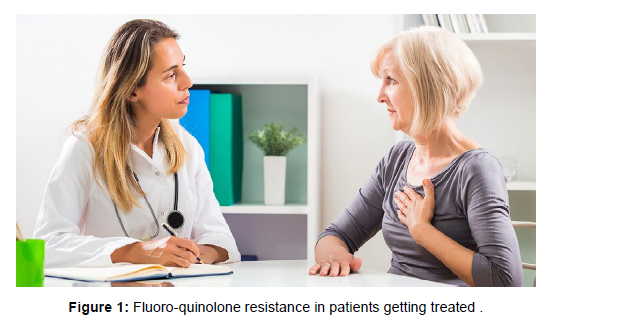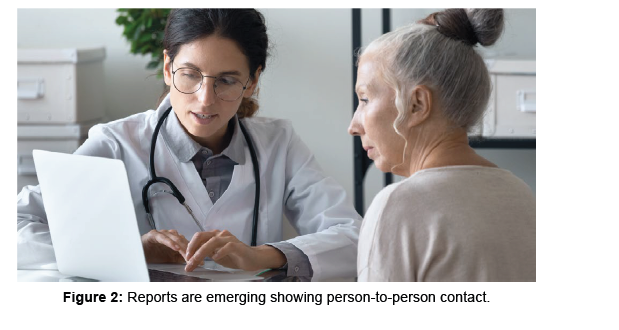Airway dilatation and pulmonary emphysema reflect obstructive lung disease
Received: 28-Aug-2023 / Manuscript No. JRM-23-115285 / Editor assigned: 31-Aug-2023 / PreQC No. JRM-23-115285 / Reviewed: 14-Aug-2023 / QC No. JRM-23-115285 / Revised: 20-Sep-2023 / Published Date: 27-Sep-2023 DOI: 10.4172/jrm.1000178 QI No. / JRM-23-115285
Abstract
Antibiotics are the first-line therapy for Legionella pneumonia. Failure to administer appropriate antimicrobial therapies at early stage of infection is associated with high mortality rates. The correct choice of antibiotic depends not only on its in vitro bactericidal or bacteriostatic activity but also on its ability to penetrate the cell membrane of host tissues because Legionella resides within host tissue cells. Fluoro-quinolones and macrolides are the most commonly used and highly effective antibiotics to treat patients with legionnaire’s disease.
Keywords: Legionnaires disease; Azithromycin; Fluoro-quinolone resistance; PCR assays; Ciprofloxacin; Aspartate aminotransferase
Keywords
Legionnaires disease; Azithromycin; Fluoro-quinolone resistance; PCR assays; Ciprofloxacin; Aspartate aminotransferase
Introduction
Including these agents in initial treatment regimen is prudent if Legionella infection is suspected based on an on-going outbreak in the area, travel history, or extra-pulmonary symptoms. It was found during the first reported outbreak of legionnaire’s disease that tetracycline and erythromycin are more effective than other antibiotics, such as b-lactam antibiotics, whereas the use of steroids has been associated with unfavourable outcome. Erythromycin has been the antibiotic of choice for the treatment of legionnaire’s disease that is highly effective but has been associated with significant side effects, especially when used intravenously [1]. Azithromycin, another macrolide, has been shown highly effective in treating patients with Legionella infection, with minor side effects. Azithromycin has been successfully used to treat Legionella infection not responding to erythromycin and is frequently chosen to treat patients infected with Legionella. Other antibiotics that are effective against Legionella are clarithromycin, rifampin, ciprofloxacin, and doxycycline, and these are used either alone or with erythromycin. In a prospective study, it has been shown that fluoro-quinolones are at least as effective as erythromycin in treating patients with legionnaire’s disease [2 ].
Methodology
Levofloxacin, either 500 mg for 10 days or 750 mg for 5 days, can cure most of the patients and is becoming the antibiotic of choice for legionnaire’s disease. Use of levofloxacin is increasing to treat Legionella infection and is associated with early clinical response and shorter hospital stay. A meta-analysis by burdet and colleagues revealed quinolones may be superior to macrolides in treating the Legionella infection. The usual duration of therapy for most of the antibiotics is 5 to 10 days and is often sufficient to completely treat patients with Legionella infection, but duration of therapy up to 3 weeks may be considered in immune-compromised patients. The route of administration used for the antibiotics depends on the severity of the infection, with parenteral therapy preferred for severe infections. If intravenous therapy is initiated early in infection, then therapy can be transitioned to oral route to complete therapy once a desirable response is observed [3]. Acquired antibiotic resistance among Legionella species can be seen in vitro but is rarely reported in vivo, although a recent report has shown the presence of fluoro-quinolone resistance in Legionella in patients who are treated with these antibiotics as shown in (Figure 1). These reports warrant special attention toward ineffectiveness or relapse of disease during on-going antibiotic therapy [4 ].
Discussion
Most cases of legionnaires disease reported are due to Legionella pneumophila serotype-1. This might reflect a diagnosis bias because most of the commercial kits available detect Legionella serotype-1 antigen in urine samples but not for other species. Efforts are under way to develop rapid diagnostic test for Legionella species, such as multiplex PCR assays, and may be more efficacious than detection of Legionella pneumophila serotype-1 antigen in patients’ urine. To date, there are few reported cases of Legionella species that are resistant to conventional antibiotics resistance and there is little evidence that combination therapy is superior to mono-therapy [5]. Legionella resistant to ciprofloxacin has been reported. It was unclear if the strain of Legionella was resistant at the presentation of disease or developed resistance during treatment because the patient was treated with ciprofloxacin and clinically improved from severe infection. Regardless, several new antibiotics are under development that target intracellular organisms, such as Legionella, either by favouring a low pH enthronement or by inhibiting bacterial protein synthesis [6]. Currently, these therapies are not available for clinical use. Person-to-person transfer is usually not considered a route of transmission for legionella, however, reports are emerging showing person-to-person transfer as shown in (Figure 2). Despite these reports, person-to- person contact seems to be the exception. The best means of preventing disease is by thwarting the contamination of water supplies [7]. Water temperature, pipe age, and pipe configuration have been shown to play a role in the contamination of water supplies with Legionella. Current recommendations to prevent Legionella contamination include maintaining water temperature outside the optimal temperature for Legionella growth, preventing stagnation, superheat-and-flush or point-of-use filters, UV irradiation, and chemical disinfection. Currently there are no clear recommendations as to optimal combination of preventative measures; therefore, despite the method of prevention utilized, the World Health Organization recommends quarterly water testing [8]. Classically, pneumonia due to C pneumonia presents as a mild illness predominated by fever and cough, often preceded by upper respiratory symptoms of rhinitis and sore throat. A study of an outbreak by Conklin and colleagues, duration of cough ranged from 64 days with a mean of few days [9]. Although the classic presentation is associated with non-productive cough, approximately patients presented with sputum production in out breaks of C pneumonia infection in earlier years. The presentation is especially difficult to distinguish from pneumonia due to Mycoplasma pneumonia or respiratory viruses [10]. Despite previous suggestions that hoarseness and laryngitis are more common in infection from C pneumonia than from M pneumonia, comparison of clinical features of both causes has shown the opposite [11]. Punji and colleagues demonstrated that cough, rhinitis, and hoarseness were significantly more common in M pneumonia infection than in C Pneumonia infection [12 ]. In the same study, C-reactive protein and aspartate aminotransferase elevations were significantly greater in C pneumonia infection than in M pneumonia infection. Other clinical symptoms and laboratory findings due to the pathogens were not significantly different. C-reactive protein and white blood cell values have been previously shown significantly lower in both C pneumonia and M pneumonia pneumonia than in pneumonia due to Streptococcus pneumonia [13]. No single symptom, laboratory finding, or collection of findings can reliably distinguish pneumonia due to C pneumonia from pneumonia due to other respiratory pathogens [14]. Additionally, C pneumonia infection may occur concomitantly with other pathogens, which may influence clinical presentation. On initial chest radiograph, a unilateral pattern of alveolar infiltrates or bronchopneumonia predominates.
Findings are usually confined to a single lobe with lower lobe involvement more frequent than middle or upper lobe involvement.
A pattern of interstitial pneumonia is comparatively rare. Up to a quarter of patients may demonstrate a small to moderate-size pleural effusion.
Conclusion
Hilar lymphadenopathy is an uncommon finding on chest radiograph. Findings may depend on the timing of imaging in the course of the illness, the method of diagnosis, and whether concomitant infection with another respiratory pathogen is excluded. In a review of patients classified as having primary infection, admission chest radiographs showed predominantly unilateral findings with repeat chest radiographs took an average of few days later showing predominantly bilateral findings
Acknowledgement
None
Conflict of Interest
None
References
- Kahn LH (2006) Confronting zoonoses, linking human and veterinary medicine. Emerg Infect Dis US 12:556-561.
- Bidaisee S, Macpherson CNL (2014) Zoonoses and one health: a review of the literature. J Parasitol 2014:1-8.
- Cooper GS, Parks CG (2004) Occupational and environmental exposures as risk factors for systemic lupus erythematosus. Curr Rheumatol Rep EU 6:367-374.
- Parks CG, Santos ASE, Barbhaiya M, Costenbader KH (2017) Understanding the role of environmental factors in the development of systemic lupus erythematosus. Best Pract Res Clin Rheumatol EU 31:306-320.
- Barbhaiya M, Costenbader KH (2016) Environmental exposures and the development of systemic lupus erythematosus. Curr Opin Rheumatol US 28:497-505.
- Cohen SP, Mao J (2014) Neuropathic pain: mechanisms and their clinical implications. BMJ UK 348:1-6.
- Mello RD, Dickenson AH (2008) Spinal cord mechanisms of pain. BJA US 101:8-16.
- Bliddal H, Rosetzsky A, Schlichting P, Weidner MS, Andersen LA, et al (2000) A randomized, placebo-controlled, cross-over study of ginger extracts and ibuprofen in osteoarthritis. Osteoarthr Cartil EU 8:9-12.
- Maroon JC, Bost JW, Borden MK, Lorenz KM, Ross NA, et al. (2006) Natural anti-inflammatory agents for pain relief in athletes. Neurosurg Focus US 21:1-13.
- Birnesser H, Oberbaum M, Klein P, Weiser M (2004) The Homeopathic Preparation Traumeel® S Compared With NSAIDs For Symptomatic Treatment Of Epicondylitis. J Musculoskelet Res EU 8:119-128.
- Gergianaki I, Bortoluzzi A, Bertsias G (2018) Update on the epidemiology, risk factors, and disease outcomes of systemic lupus erythematosus. Best Pract Res Clin Rheumatol EU 32:188-205.]
- Cunningham AA, Daszak P, Wood JLN (2017) One Health, emerging infectious diseases and wildlife: two decades of progress? Phil Trans UK 372:1-8.
- Sue LJ (2004) Zoonotic poxvirus infections in humans. Curr Opin Infect Dis MN 17:81-90.
- Pisarski K (2019) The global burden of disease of zoonotic parasitic diseases: top 5 contenders for priority consideration. Trop Med Infect Dis EU 4:1-44.
Indexed at, Google Scholar, Crossref
Indexed at, Google Scholar, Crossref
Indexed at, Google Scholar, Crossref
Indexed at, Google Scholar, Crossref
Indexed at, Google Scholar, Crossref
Indexed at, Google Scholar, Crossref
Indexed at, Google Scholar, Crossref
Indexed at, Google Scholar, Crossref
Indexed at, Google Scholar, Crossref
Indexed at, Google Scholar, Crossref
Indexed at, Google Scholar, Crossref
IndexedAt , Google Scholar, Crossref
Indexed at, Google Scholar, Crossref
Citation: Vilozni D (2023) Airway Dilatation and Pulmonary Emphysema ReflectObstructive Lung Disease. J Respir Med 5: 178. DOI: 10.4172/jrm.1000178
Copyright: © 2023 Vilozni D. This is an open-access article distributed under theterms of the Creative Commons Attribution License, which permits unrestricteduse, distribution, and reproduction in any medium, provided the original author andsource are credited.
Select your language of interest to view the total content in your interested language
Share This Article
Recommended Journals
Open Access Journals
Article Tools
Article Usage
- Total views: 1259
- [From(publication date): 0-2023 - Nov 20, 2025]
- Breakdown by view type
- HTML page views: 941
- PDF downloads: 318


